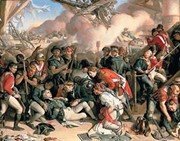Daniel Maclise
Irish History Painter, Portrait Artist.
Biography, Paintings.
![]()
![]()
|
Daniel Maclise |
 Death of Nelson (Detail) |
Daniel Maclise RA (1806–1870)One of the most successful painters in the history of Irish art, the historical artist and portraitist Daniel Maclise was born in Cork. Despite a rudimentary education he was an avid reader and anxious to learn. After two years as a bank clerk, he attended classes at the Cork Crawford School of Art. In 1825, when the famous novelist Sir Walter Scott was travelling in Ireland, Maclise spied him in a book shop and promptly made a casual sketch of him, which he lithographed and sold. The sketch was exceptionally well received and Maclise became in great demand as a portrait painter. These early portrait sketches he executed in pencil, with a keen eye for detail and accessory. |
|
For a comparison with a |
 |
Being of an independent spirit, Maclise turned down all offers of financial assistance to promote his artistic talent and saved enough to leave for London. Another chance sketch, this time of the younger Kean was lithographed and published, and in 1828 he entered the Royal Academy Art School where he duly won a number of high awards. The following year, Maclise exhibited for the first time at the Royal Academy (RA). As time passed, Maclise started to narrow his painting focus, concentrating on subject and history painting, interspersed with portraits of Campbell, Miss Landon, Charles Dickens, and other literary friends. In 1833, he showed two paintings - "Chivalric Vow of the Ladies" and "The Peacock" - which significantly enhanced his reputation as a painter. In 1835 he became an associate of the Royal Academy, and in 1840 a full member. Over the following years the subject matter of his paintings included a number of people and scenes from history and tradition as well as from the works of Shakespeare, Goldsmith and Le Sage. |
|
In addition, Maclise also illustrated several of Charles Dickens's Christmas books and other works. Also, during the early 1830s, he executed a series of portraits of literary and other celebrities of the time, as well as caricatures, which were afterwards published as the Maclise Portrait Gallery (1871). In 1858, he started on one of two monumental works, "The Meeting of Wellington and Blucher", on the walls of Westminster Palace. Unsuccessfully begun in fresco, it was eventually completed using water-glass painting, as was his second great work "The Death of Nelson". These efforts proved excessively tiring for Maclise. In 1865, when he was offered the presidency of the Royal Academy, he declined the honor, dying five years later of pneumonia. See also English Figurative Painting 18th/19th century. One of the great contributors to the reputation of visual art in Ireland, the name of this great Cork artist lives on in The Maclise Art Society, Cork City's foremost fine art group. |
|
More Information About Visual Arts in Ireland • For details of other history painters,
see: Irish Artists: Paintings and Biographies. ENCYCLOPEDIA OF VISUAL ARTISTS IN IRELAND |